A Japanese M-5 rocket lifted off on Friday carrying a spacecraft which will be the first to ever collect samples from the surface of an asteroid. Called Muses-C, the spacecraft will take only two years to reach asteroid 1998 SF 36 – one of the Earth?s closest space neighbours ? and then return to Earth by 2007. A grapefruit-sized marker imprinted with nearly 900,000 names will also be dropped onto the asteroid?s surface.
Space Pioneer Unveils Rocket Prototype
Aerospace pioneer Bart Rutan has created what he calls the world’s first private space program. The three-person capsule, rocket and launch aircraft, together dubbed SpaceShipOne, were unveiled at Scaled Composite’s facilities in California on Friday to several hundred guests. Rutan and his team plans a series of test flights culminating at an attempt to win the X-Prize (the first privately built spacecraft to reach space).
Columbia Investigators Release Preliminary Report
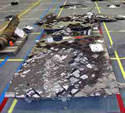
Image credit: NASA
The Columbia Accident Investigation Board, the group attempting to determine what destroyed the space shuttle Columbia in February, released some preliminary recommendations for NASA to prevent future shuttle accidents. They recommended increased inspections of several shuttle components as well as taking images of the shuttles while they’re in orbit by various space-based cameras to detect any damage.
Houston, Texas — The Columbia Accident Investigation Board today issued two preliminary recommendations to NASA. Additionally, the Board issued several facts regarding the shuttle program.
Recommendation One: Prior to return to flight, NASA should develop and implement a comprehensive inspection plan to determine the structural integrity of all Reinforce Carbon-Carbon (RCC) system components. This inspection plan should take advantage of advanced non-destructive inspection technology.
This recommendation was issued because of the board’s finding that current inspection techniques are not adequate to assess structural integrity of RCC, supporting structure, and attaching hardware.
Recommendation Two: Prior to return to flight, NASA should modify its Memorandum of Agreement with National Imagery and Mapping Agency (NIMA) to make on-orbit imaging for each Shuttle flight a standard requirement.
This recommendation was issued because of the board’s finding that the full capabilities of the United States Government to image the Shuttle on orbit were not utilized.
Facts Regarding RCC Components — The board will include the following facts in its final report:
* The Reinforced Carbon-Carbon (RCC) system (including all RCC, supporting structure and attaching hardware) is an essential component of the Space Shuttle Orbiter Thermal Protection System (TPS) and has a Criticality Rating of 1 (loss of crew – loss of vehicle).
* The RCC composite consists of a reinforced carbon-carbon substrate that carries the structural loads, a tetraethyl orthosilicate impregnation that reduces inherent substrate porosity, a silicon carbide treatment that protects the substrate from oxidation, and a sealant coating that provides additional oxidation protection. These composite structures are attached to the shuttle by a metal support system.
* During initial manufacturing acceptance, the integrity of production composites used in the RCC system is checked at various points in production by physical tap, ultrasonic, radiographic, eddy current, weight gain, and visual tests. In addition, a flat plate control panel made in parallel with the production piece is destructively tested at various points in the production process.
* A projected design mission life has been established for each RCC component. These projections are based on analysis correlated to simulated flight load testing, and assume the presence of sound composite material and metal support structure.
* Visual external inspections and tactile checks are the only specified post flight inspections of RCC composite components. The planned interval for removing RCC composite components for more thorough inspection is typically many flights, unless their removal is dictated by an observed visual surface condition or necessitated by the requirement to provide access for other operations.
* Non-destructive testing of some post-flight RCC components has shown indications of RCC material defects not previously identified by visual inspection methods currently employed.
Facts Regarding Shuttle Imaging — The board will include the following facts in its final report:
* The U.S. Government has the capability to image the Shuttle on orbit.
* A Memorandum of Agreement exists between NASA and NIMA regarding on-orbit imaging of the Shuttle.
* During the flight of STS-107, there were no on-orbit images taken of sufficient resolution to assess the Orbiter’s condition.
The CAIB issued these recommendations and findings in advance of their appearance in the final report. The board’s final report will be issued later this summer. It will include the probable cause of the accident, contributing factors, findings and additional recommendations.
Original Source: CAIB News Release
Satellite Monitors Dangerous Glacier
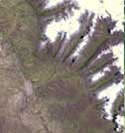
Image credit: NASA
NASA’s Terra satellite is keeping a watchful camera pointed towards a glacier in the mountains of Peru. A large crack has appeared in the sheet of ice, and it could crumble into Lake Palcacocha, sending a wall of water and rubble into a nearby town of 60,000 people. This has been a controversial announcement, however, with several US and Peruvian geologists feel that the danger is exaggerated.
An Earth-monitoring instrument aboard NASA’s Terra satellite is keeping a close eye on a potential glacial disaster-in-the-making in Peru’s spectacular, snow-capped Cordillera Blanca (White Mountains), the highest range of the Peruvian Andes.
Data from NASA’s Advanced Spaceborne Thermal Emission and Reflection Radiometer (Aster) is assisting Peruvian government officials and geologists in monitoring a glacier that feeds Lake Palcacocha, located high above the city of Huaraz, 270 kilometers (168 miles) north of Lima. An ominous crack has developed in the glacier. Should the large glacier chunk break off and fall into the lake, the ensuing flood could hurtle down the Cojup Valley into the Rio Santa Valley below, reaching Huaraz and its population of 60,000 in less than 15 minutes.
“Remote sensing instruments like Aster can serve a vital role in mountain hazard management and disaster mapping by providing rapid access to data, even in regions not easily accessible by humans,” explained Dr. Michael Abrams, associate Aster team leader at NASA’s Jet Propulsion Laboratory, Pasadena, Calif.
“Aster’s unique vantage point from space gives scientists another tool with which to see early signs of potential glacial flood-burst events and to monitor changes in glacial behavior over time. In Huaraz, Peruvian authorities and scientists will incorporate Aster data along with data from ground-based monitoring techniques to better assess current conditions and take steps necessary to reduce risks to human lives and property,” Abrams said.
Comparison images of the area and more information are available at: http://photojournal.jpl.nasa.gov/catalog/PIA03899. Huaraz can be seen in the images’ left-center, with Lake Palcacocha in the images’ upper right corners at the head of a valley, below the snow and glacier cap. The left image was acquired on November 5, 2001; the right on April 8, 2003.
Glacial flood-bursts, known by Peruvians as “aluviones,” occur periodically when water is released abruptly from a previously ice-dammed lake alongside, within, or above a glacier. The release can be caused by various triggering events. These flood-bursts typically arrive with little or no warning, carrying liquid mud, large rock boulders and blocks of ice.
The Rio Santa Valley is no stranger to such disasters. Since 1702, floods caused by glaciological conditions have repeatedly caused death and destruction in the region. One particularly devastating event in 1941 destroyed approximately one-third of Huaraz, killing an estimated 5,000 to 7,000 people. Since then, the Peruvian government has emphasized control of the water level in Lake Palcacocha and other lakes in the region that pose similar threats. The efforts appear to have worked; since 1972, no destructive floods resulting from the breakout of glacial lakes have occurred. Nevertheless, officials are still monitoring the current situation closely.
Aster’s broad spectral coverage and high spectral resolution is ideally suited for monitoring dynamic conditions and changes in Earth’s landscape over time, including glacial advances and retreats. Its 14 spectral bands measure from the visible to the thermal infrared wavelength region, and it can “see” at a resolution of 15 to 90 meters (about 50 to 300 feet).
Aster provides scientists in numerous disciplines with critical information used for surface mapping and monitoring of dynamic conditions and changes over time. Example applications include monitoring glacial advances and retreats and potentially active volcanoes; identifying crop stress; determining cloud morphology and physical properties; evaluating wetlands; monitoring thermal pollution and coral reef degradation; mapping surface temperatures of soils and geology; and measuring surface heat balance. It can also image the same area as frequently as every other day in response to urgent priorities.
Aster is one of five Earth-observing instruments launched December 18, 1999, on NASA’s Terra satellite. Japan’s Ministry of Economy, Trade and Industry built the instrument. A joint U.S./Japan science team is responsible for validation and calibration of the instrument and the data products.
The Terra satellite is part of NASA’s Earth Science Enterprise, a program dedicated to understanding the Earth as an integrated system and applying Earth system science to improve prediction of climate, weather and natural hazards using the unique vantage point of space.
The California Institute of Technology in Pasadena manages JPL for NASA.
Original Source: NASA/JPL News Release
X-Rays Seen from Brown Dwarf Star
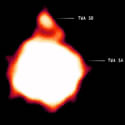
Image credit: Chandra
The latest photos released from the Chandra X-Ray Observatory show x-rays produced from a brown dwarf which is orbiting a binary star system at a distance of 2.75 times that of the Pluto Charon orbit around the Sun. The star system is 180 light-years away from Earth in the constellation of Hydra. The brown dwarf, TWA 5B, is a failed star between 15 and 40 times the size of Jupiter.
A Chandra observation revealed X-rays produced by TWA 5B, a brown dwarf star orbiting a young binary star system known as TWA 5A. The star system is 180 light years from the Earth and a member of a group of about a dozen young stars in the Hydra constellation. The brown dwarf orbits the binary star system at a distance about 2.75 times that of Pluto’s orbit around the Sun.
The sizes of the sources in the image are due to an instrumental effect that causes the spreading of pointlike sources. For a comparison of the actual size of TWA 5B to the Sun and the planet Jupiter, see the illustration below.
Brown dwarfs are often referred to as “failed stars” because they are under the mass limit (about 80 Jupiter masses, or 8 percent of the mass of the Sun) needed to spark the nuclear fusion of hydrogen to helium which supplies the energy for stars such as the Sun. Lacking any central energy source, brown dwarfs are intrinsically faint and draw their energy from a very gradual shrinkage or collapse.
Young brown dwarfs, like young stars, have turbulent interiors. When combined with rapid rotation, this turbulent motion can lead to a tangled magnetic field that can heat their upper atmospheres, or coronas, to a few million degrees Celsius. The X-rays from both TWA 5A and TWA 5B are from their hot coronas.
TWA 5B is estimated to be only between 15 and 40 times the mass of Jupiter, making it one of the least massive brown dwarfs known. Its mass is rather near the boundary (about 12 Jupiter masses) between planets and brown dwarfs, so these results could have implications for the possible X-ray detection of very massive planets around stars.
Original Source: Chandra News Release
Mars Rover Delayed to Fix Glitch
NASA engineers will need to disassemble both of their Mars rovers to fix an electrical device which could have caused a catastrophic short circuit later in the mission. This delay will push the launch of the first rover a week to no earlier than June 6, with the second launching two weeks later as scheduled. The twin rovers will perform a series of geologic experiments on Mars to search for evidence of past water.
Russia’s President Vow’s Additional Space Station Support
During a video conference with the crew of the International Space Station on Saturday, Russian President Vladimir Putin said that they would send additional spacecraft during the US freeze on shuttle flights. “If it comes to it, we will look at the question of Russia taking on further work in the ISS.” A replacement 2-man crew is due to launch on April 26.
Six New Moons Found Around Jupiter
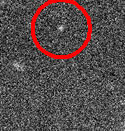
Image credit: University of Hawaii
Astronomers from the University of Hawaii have discovered six new moons for Jupiter, pushing the planet’s satellite count to 58 – the largest group of moons in the Solar System. These aren’t terribly big moons, though, only a kilometer or so across. The moons were discovered as part of an ongoing search using the world’s largest digital cameras at the Subaru and Canada-France-Hawaii telescopes atop Mauna Kea.
The majority of the new satellites were first seen in early February 2003 by Scott S. Sheppard and David C. Jewitt from the Institute for Astronomy, University of Hawaii along with Jan Kleyna of Cambridge University. The satellites were detected using the world’s two largest digital cameras at the Subaru (8.3 meter diameter) and Canada-France-Hawaii (3.6 meter diameter) telescopes atop Mauna Kea in Hawaii. Both telescopes and their imaging cameras represent the latest technology has to offer. Recoveries were performed at the University of Hawaii 2.2 meter with help from Yanga Fernandez and Henry Hsieh also from the University of Hawaii. Brian Marsden of the Harvard-Smithsonian Center for Astrophysics performed the orbit fitting for the new satellites.
The first 7 satellites were formally announced by the International Astronomical Union on Circular No. 8087 on March 4, 2003 while the eighth was announced on Circular No. 8088 on March 6, the 9th through 12th on Circular No. 8089 on March 7, S/2003 J13 through J20 were announced in April, and S/2003 J21 in May*. Except for S/2003 J20, all the new Jupiter satellites appear to have distant retrograde orbits (ie. their orbital rotation is opposite to Jupiter’s rotation) like the majority of the known irregular satellites of Jupiter. The satellite S/2003 J20 appears to be a prograde satellite dynamically distinct from any other known Jupiter satellite.
Original Source: IFA News Release
Astronauts Take Last Spacewalk for a While
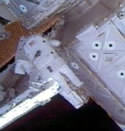
Image credit: NASA
Astronauts Ken Bowersox and Don Pettit spent more than six hours working outside the International Space Station today to wrap a few upgrades. Because NASA will be switching to two-astronaut teams shortly, this will likely be the last spacewalk for several months – one astronaut needs to stay on board the station during any walk for safety. The current crew has been on board since November, and was supposed to return some time in March, but the Columbia disaster has pushed their return back indefinitely.
Expedition 6 Commander Ken Bowersox and NASA Science Officer Don Pettit reconfigured critical power cables and continued the external outfitting of the International Space Station today during a 6 hour, 26 minute spacewalk designed to complete a number of get-ahead tasks for future ISS assembly.
Taking advantage of the final days of a three-man presence on the ISS before the new Expedition 7 crew is launched, Bowersox and Pettit began the second spacewalk of their increment at 7:40 a.m. CDT (1240 GMT). It was the second spacewalk for both Bowersox and Pettit, the 51st spacewalk for ISS assembly and maintenance and the 17th spacewalk staged from the U.S. Quest Airlock. Flight Engineer Nikolai Budarin helped the crew suit up and monitored ISS systems from inside the Destiny Laboratory during the excursion.
Bowersox and Pettit set out immediately to set up tools and tethers, and quickly went to work on separate tasks. Bowersox reconfigured electrical connectors at the interfaces between the Starboard Zero (S0) Truss and the two trusses flanking it, the Starboard One (S1) Truss and the Port 1 (P1) Truss. The connector work will insure that additional protection is in place to prevent the inadvertent release of the truss segments from the S0 Truss through the trusses? Bolt Bus Controller system. Bowersox also inspected a faulty heater cable on the P1 Truss Nitrogen Tank Assembly but found nothing unusual.
While that work was being conducted, Pettit replaced a power relay box in the Mobile Transporter railcar system, which has experienced some electrical problems in recent weeks.
Both spacewalkers then made their way to the Z1 (Zenith One) Truss, where they successfully rerouted power cables to two of the four Control Moment Gyros (CMGs) that provide orientation control for the ISS from the U.S. segment. One CMG failed almost a year ago, and the cable reconfiguration to CMGs # 2 and 3 will prevent both from being disabled in the unlikely event a power failure occurs. The ISS can be properly oriented with just two CMGs in operation. A replacement for the failed CMG will be flown to the ISS and installed on the first post-Columbia shuttle mission, STS-114.
Bowersox and Pettit pressed ahead to install two so-called Spool Positioning Devices on fluid quick disconnect lines for the heat exchanger on the Destiny Laboratory. The devices help keep internal seals and moving parts from experiencing internal leakage as ammonia flows through the station?s cooling system.
With that completed, the two station crewmembers ventured to the S1 Truss to secure a thermal cover on the truss? Radiator Beam Valve Module, which controls the flow of ammonia to the truss? heat-rejecting radiators.
One final task awaited Bowersox and Pettit — the deployment of a balky light stanchion for the handrail cart on the S1 Truss that would not unfurl during the previous spacewalk by the two crewmembers in January. The stanchion proved to be just as stubborn this time, but Pettit used a hammer to tap the stanchion free from its stowed position on the 10th try. A light was then installed on the stanchion, giving the truss the illuminating capability it needs to assist future spacewalkers.
With all of their work completed, Bowersox and Pettit retrieved some tools for future spacewalks from external locations and returned to Quest to complete their spacewalk at 2:06 p.m. CDT (1906 GMT).
The crew will spend a quiet day tomorrow relaxing before resuming its complement of scientific research and routine maintenance work on board the ISS Thursday.
Meanwhile, Expedition 7 Commander Yuri Malenchenko and Flight Engineer/NASA ISS Science Officer Ed Lu completed final preparations before traveling to the Baikonur Cosmodrome in Kazakhstan tomorrow from their training base in Star City, Russia to inspect the Soyuz TMA-2 vehicle in which they will be launched on April 26 to begin a six-month mission on the ISS.
Original Source: NASA News Release
Hubble Watches Star Erupt
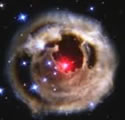
Image credit: Hubble
A recent set of images taken by the Hubble Space Telescope show a dull star that suddenly became 600,000 times brighter. The star, called V838 Monocerotis, is located 20,000 light-years from Earth and astronomers are unsure exactly why it flared up so brightly ? temporarily becoming the brightest star in the Milky Way. The outburst was similar to a nova, but unlike this fairly common occurrence, V838 didn’t slough off its outer layers.
In January 2002, a dull star in an obscure constellation suddenly became 600,000 times more luminous than our Sun, temporarily making it the brightest star in our Milky Way galaxy.
The mysterious star has long since faded back to obscurity, but observations by NASA’s Hubble Space Telescope of a phenomenon called a “light echo” have uncovered remarkable new features. These details promise to provide astronomers with a CAT-scan-like probe of the three-dimensional structure of shells of dust surrounding an aging star. The results appear tomorrow in the journal Nature.
“Like some past celebrities, this star had its 15 minutes of fame,” says Anne Kinney, director of NASA’s Astronomy and Physics program, Headquarters, Washington. “But its legacy continues as it unveils an eerie light show in space. Thankfully, NASA’s Hubble has a front row seat to this unique event in our galaxy.”
Light from a stellar explosion echoing off circumstellar dust in our Milky Way galaxy was last seen in 1936, long before Hubble was available to study the tidal wave of light and reveal the netherworld of dusty black interstellar space.
“As light from the outburst continues to reflect off the dust surrounding the star, we view continuously changing cross-sections of the dust envelope. Hubble’s view is so sharp that we can do an ‘astronomical cat-scan’ of the space around the star,” says the lead observer, astronomer Howard Bond of the Space Telescope Science Institute in Baltimore.
Bond and his team used the Hubble images to determine that the petulant star, called V838 Monocerotis (V838 Mon) is about 20,000 light-years from Earth. The star put out enough energy in a brief flash to illuminate surrounding dust, like a spelunker taking a flash picture of the walls of an undiscovered cavern. The star presumably ejected the illuminated dust shells in previous outbursts. Light from the latest outburst travels to the dust and then is reflected to Earth. Because of this indirect path, the light arrives at Earth months after light coming directly toward Earth from the star itself.
The outburst of V838 Mon was somewhat similar to that of a nova, a more common stellar outburst. A typical nova is a normal star that dumps hydrogen onto a compact white-dwarf companion star. The hydrogen piles up until it spontaneously explodes by nuclear fusion ? like a titanic hydrogen bomb. This exposes a searing stellar core, which has a temperature of hundreds of thousands of degrees Fahrenheit.
By contrast, however, V838 Mon did not expel its outer layers. Instead, it grew enormously in size, with its surface temperature dropping to temperatures not much hotter than a light bulb. This behavior of ballooning to an immense size, but not losing its outer layers, is very unusual and completely unlike an ordinary nova explosion.
“We are having a hard time understanding this outburst, which has shown a behavior that is not predicted by present theories of nova outbursts,” says Bond. “It may represent a rare combination of stellar properties that we have not seen before.”
The star is so unique it may represent a transitory stage in a star’s evolution that is rarely seen. The star has some similarities to highly unstable aging stars called eruptive variables, which suddenly and unpredictably increase in brightness.
The circular light-echo feature has now expanded to twice the angular size of Jupiter on the sky. Astronomers expect it to continue expanding as reflected light from farther out in the dust envelope finally arrives at Earth. Bond predicts that the echo will be observable for the rest of this decade.
The research team included investigators from the Space Telescope Institute in Baltimore; the Universities Space Research Association at the U.S. Naval Observatory in Flagstaff, Ariz.; the European Space Agency; Arizona State University; the Large Binocular Telescope Observatory at the University of Arizona at Tucson; the Isaac Newton Group of Telescopes in Spain’s Canary Islands; and the INAF-Osservatorio Astronomico di Padova in Asiago, Italy.
Original Source: Hubble News Release
